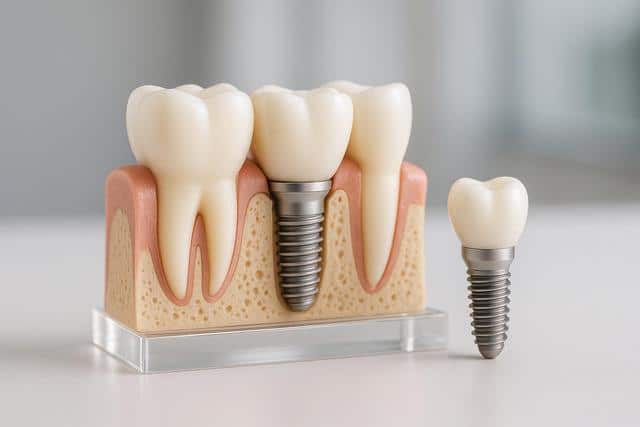
Dental Implants: Benefits, Longevity, and Everyday Care
What dental implants are, and what this article covers
Dental implants are small posts placed in the jaw to support a crown, bridge, or denture. They’re valued because they feel stable, help distribute chewing forces, and can preserve facial structure by stimulating the jawbone. This article focuses on three essentials promised in the headline: the key benefits and trade-offs of implants, the factors that influence longevity, and the everyday care steps that support long-term success. You’ll also find a practical comparison table, expert quotes, and a frequently asked questions section.
Benefits and risks at a glance
Dental implants can restore chewing, stabilize adjacent teeth, and help maintain jawbone volume when used in appropriate cases. Equally important, they carry risks that your clinician will review: surgical complications, infection, sinus or nerve involvement depending on location, and the potential for peri-implant inflammation if plaque control is inconsistent. The U.S. regulator’s patient page outlines both sides and reminds patients to alert imaging teams about implants before MRI or X-ray appointments [1]. For a plain-language clinical overview of what an implant is and how it connects to an abutment and crown, see the specialty college’s FAQ [2].
Expert quote: “Carefully follow the oral hygiene instructions given to you by your dental provider.” [1]
How long do dental implants last?
Longevity depends on health status, implant position, bite forces, hygiene, and professional maintenance. Large long-term cohorts report high survival over 10–15 years, with patient-level risks increasing for smokers and people with diabetes. One study following 10,871 implants reported cumulative survival of 96.8% at 10 years and 94.0% at 15 years (implant-level), with smoking and diabetes associated with failures [3]. A 38–40 year follow-up of single-tooth implants found high implant survival but lower crown survival, underscoring that restorations may need replacement even when the implant remains stable [4].
Inflammatory complications can occur even as implants survive. In edentulous maxillae with implant overdentures, 10-year patient-level peri-implantitis incidence approached 20% [10]. For immediately loaded full-arch cases, 10-year implant survival around 96% was paired with a lower percentage of implants free from peri-implantitis, highlighting the value of ongoing maintenance [11].
Everyday home care that supports longevity
Daily plaque control is central to keeping tissues around an implant healthy. European periodontal guidance emphasizes three pillars: avoid smoking, practice consistent home care, and attend regular checkups. Their home routine highlights twice-daily brushing for two minutes and interdental cleaning (interdental brushes or floss) at least once daily [5]. Complement this with general ADA home-care guidance—including between-teeth cleaning and water-flossing as an option—to reach areas a brush can’t [6].
Some patients benefit from adjunctive tools. Specialty groups note that floss threaders or specialty floss can aid cleaning under bridges and around multiple-implant restorations, and that a water flosser can be a helpful add-on; your dentist can advise on technique and whether a night guard is appropriate for clenching or grinding [7].
Professional maintenance and recall frequency
Supportive peri-implant care (professional biofilm removal, reinforcement of home care, periodic measurements) is associated with better tissue stability after treatment for peri-implant disease, although specific protocols and ideal frequencies vary across studies [8]. A consensus summary from leading implant and periodontal organizations suggests three- to four-month intervals for patients previously treated for peri-implantitis, with recall frequency reassessed after the first year [9].
Expert quote: “SPiT intervals of 3–4 months should be recommended for patients who have undergone treatment for peri-implantitis.” [9]
Materials: titanium, titanium–zirconium, and zirconia
Titanium remains the most documented implant material with consistently high survival in long-term literature. In randomized data synthesized through meta-analysis, titanium outperformed zirconia for 12‑month survival and showed less marginal bone loss, while soft-tissue indices and esthetic scores were similar between groups [12]. A broader comparative review reported survival around 97.7% for titanium, 98.6% for titanium–zirconium alloys, and 93.8% for zirconia in the studies analyzed, with no significant difference in marginal bone levels among materials [13].
What this means for you: zirconia may be considered for specific esthetic scenarios or metal sensitivities, but long-term data for titanium remain more extensive. Discuss your case goals and risk profile with your restorative dentist and surgeon.
Costs and coverage: what to expect (U.S.)
Implant costs vary by region, case complexity, imaging, grafting, and the type of restoration. Consumer-oriented overviews place a single-tooth implant package in the roughly $3,000–$6,000 range, with multi-tooth and full-arch solutions higher; dental plans, when they cover implants, often contribute a percentage up to the plan’s annual maximum [14], [15]. Some national providers publish typical ranges for single-tooth, implant-denture, and fixed full-arch solutions to help you anticipate budget discussions [16].
| Tooth replacement | Longevity (literature) | Impact on adjacent teeth | Typical maintenance | Illustrative U.S. cost ranges |
|---|---|---|---|---|
| Single implant + crown | High 10–15 yr survival; crowns may need replacement earlier [3], [4] | Does not require preparing adjacent teeth | Daily brush/interdental care; professional recalls | ~$3,000–$6,000 per tooth (varies) [14], [15] |
| Implant-supported bridge | Strong option for multiple adjacent gaps; survival influenced by span and distribution [3] | Replaces several teeth without crowning neighbors | Threaders/interdental brushes to clean under pontics | Often higher than single-tooth; provider quotes vary [16] |
| Implant overdenture (removable) | High survival; peri-implantitis risk necessitates maintenance [10] | Usually improves denture stability | Remove to clean; clean abutments; periodic liner/clip service | Varies by arch and components; provider quotes vary [15] |
| Fixed full-arch (e.g., 4–6 implants) | 10-year survival around mid-90s for implants; disease-free percentages lower without consistent care [11] | Replaces a full arch without removable plates | Meticulous daily cleaning; frequent professional maintenance | Provider-published per-arch ranges available [16] |
Candidacy and cautions
Good general health, adequate bone, and healthy gums improve predictability. Risk factors such as tobacco use and poorly controlled diabetes are linked to higher complication or failure rates; the FDA lists delayed healing and infection risks in these populations [1], while long-term cohort data likewise associate smoking and diabetes with failures [3]. Patients with a history of periodontitis may have higher long-term implant complication rates and warrant close maintenance [17].
Daily and weekly care checklist
- Brush twice daily for two minutes with a soft brush; clean between teeth and around implants once daily with interdental brushes or floss (sequence: interdental first, then brush) [5], [6].
- Consider a water flosser as an adjunct (not a replacement) if dexterity is limited [7].
- For removable implant overdentures, take them out daily and clean both the denture and the implant components; use denture cleansers as directed and never in-mouth [19].
- Schedule maintenance visits as advised; if you’ve been treated for peri-implant disease, expect shorter intervals (often every 3–4 months initially) [9].
FAQs
Frequently Asked Questions
Do implants last a lifetime?
Implants can function for decades when placed and maintained appropriately; 10–15 year survival is high in cohorts, though crowns and other components may need earlier replacement [3], [4].
How soon can I use an electric brush or water flosser after surgery?
Follow your clinician’s post-op instructions; early on, a soft manual brush and gentle technique are typical. Adjuncts like water flossers are added when tissues heal sufficiently [1], [7].
Are zirconia implants “metal-free” and do they perform the same as titanium?
Zirconia is a ceramic and can be an option in select cases; current randomized evidence suggests titanium shows higher short-term survival, with similar soft-tissue and esthetic measures [12], [13].
What does maintenance look like after peri-implantitis treatment?
Supportive care reduces recurrence risk, but protocols vary; many teams use three- to four‑month intervals at first, then individualize over time [8], [9].
Will insurance cover implants?
Coverage varies widely. Some dental plans pay part of the fee up to an annual maximum; pre-treatment estimates help avoid surprises. See overviews of common scenarios and ranges [14], [15].
Websources
- FDA: Dental Implants—What You Should Know
- American College of Prosthodontists—Dental Implants FAQ
- PubMed: Long-term performance of 10,871 implants (up to 22 years)
- ADA News: 40-year prognosis of single-tooth dental implants
- European Federation of Periodontology—Patient FAQs
- ADA MouthHealthy—Daily routine
- ASIRD—Dental implant maintenance
- PubMed: Supportive care following peri-implantitis treatment
- PMC: AO/AAP consensus on peri-implant diseases
- PubMed: 10-year peri-implant disease incidence (maxillary overdentures)
- PubMed: Full-arch rehabilitations—10-year outcomes
- PubMed: Zirconia vs titanium implants (meta-analysis)
- PubMed: Titanium, titanium–zirconium, and zirconia outcomes
- Investopedia: How to get dental implants covered by insurance
- CostHelper: Dental implant costs
- ClearChoice: Dental implants cost guide
- American Association of Endodontists: Periodontitis and implant outcomes
- ADA: Denture care and maintenance (relevant to overdentures)


